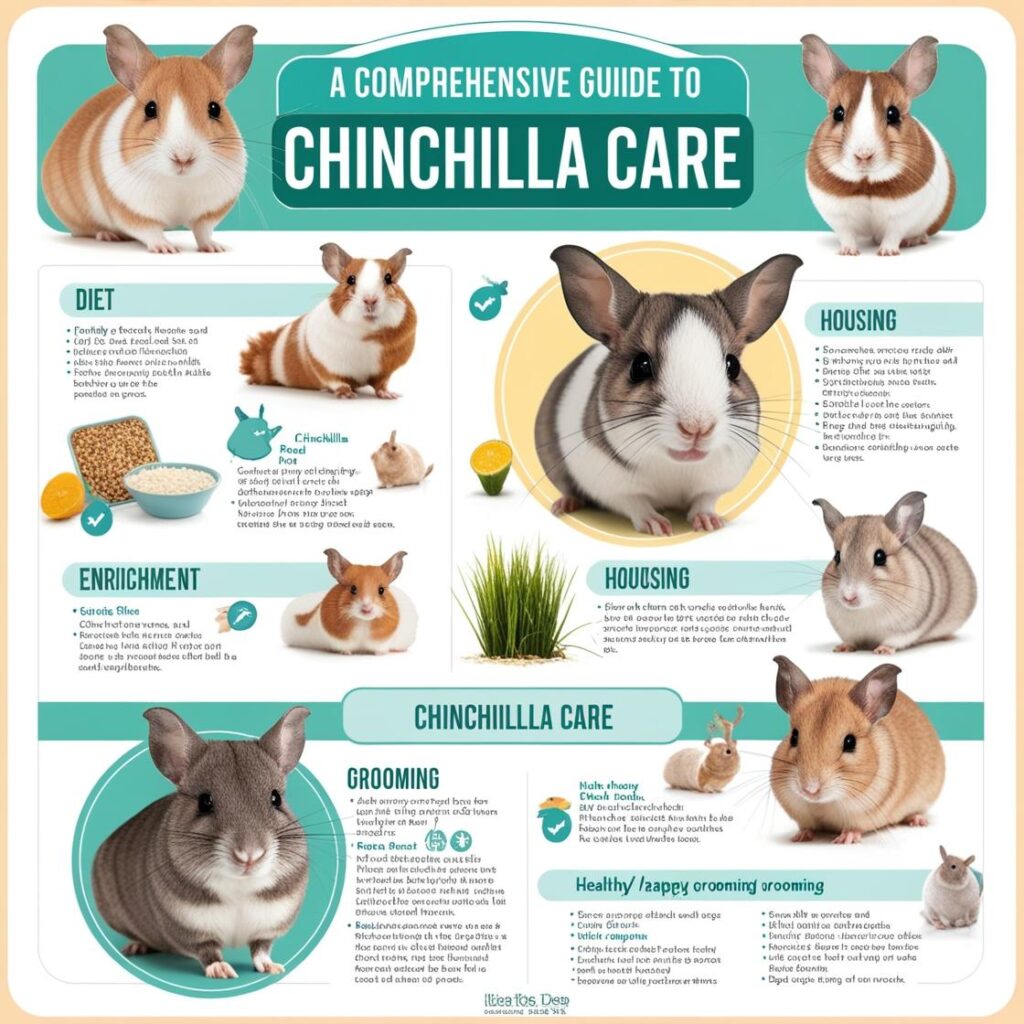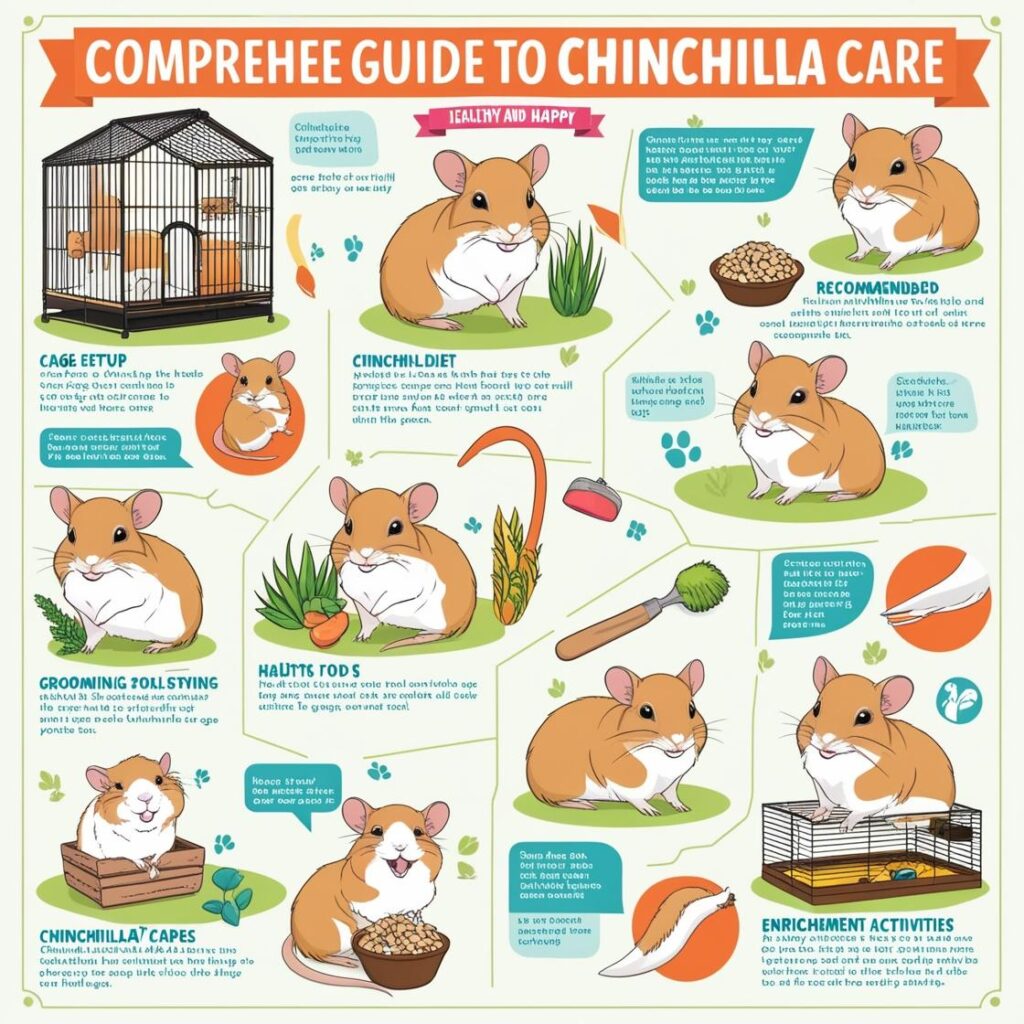Chinchillas are charming rodents native to the Andes mountains of South America. Known for their incredibly soft fur, playful demeanor, and relative rarity as pets, these creatures have gained popularity among animal enthusiasts. However, prospective and current chinchilla owners must understand the unique care requirements of these delicate animals. This comprehensive guide will explore essential aspects of chinchilla care, from housing and diet to health considerations and daily activities, ensuring that your chinchilla thrives in its home environment.

Understanding Chinchillas’ Natural Habitat
Before diving into the specifics of chinchilla care, it’s crucial to recognize that chinchillas are exotic pets with specialized needs. In their natural habitat, chinchillas live in colonies on rocky cliffs in high-altitude regions. This environment is cool, dry, and spacious; thus, the care you provide should mimic these conditions to promote their well-being.
1. Housing Requirements
Creating a suitable living space for your chinchilla is paramount. Here are key considerations for housing:
- Cage Type: Choose a large, multi-level cage made of sturdy materials like metal, as chinchillas are active climbers. A minimum cage size should be at least 2 feet wide, 2 feet deep, and 4 feet tall, allowing ample space for multiple levels and activity.
- Bedding: Use paper-based or aspen shavings for bedding, as they are absorbent and safe. Avoid cedar or pine shavings due to the high phenol content, which can be harmful to chinchillas.
- Temperature & Humidity: Chinchillas thrive in cooler temperatures (ideally between 60°F and 70°F) with low humidity. Avoid direct sunlight and heat sources; a climate-controlled environment is ideal.
- Enrichment: Provide plenty of chew toys, hiding places, and tunnels to stimulate their curiosity and chewing instincts. Natural wood or safe store-bought toys can be excellent choices.
2. Diet and Nutrition
A balanced diet is critical for maintaining the health of your chinchilla. Follow these guidelines for optimal nutrition:
- Hay: The foundation of a chinchilla’s diet should be high-quality grass hay (such as timothy hay), which provides essential fiber, aids digestion, and supports dental health. Hay should be available at all times.
- Pellets: Supplement hay with specially formulated chinchilla pellets that contain the appropriate nutrients. Opt for brands with low protein (16%-18%) and high fiber (25% or more) content.
- Fresh Vegetables: Introduce small portions of fresh vegetables like kale, parsley, or carrot tops for variety. However, limit the amount to prevent digestive issues.
- Treats: Use treats sparingly; small pieces of dried fruit or specific chinchilla-safe treats can be given occasionally.
- Fresh Water: Ensure constant access to fresh, clean water. A water bottle with a sipper tube is an ideal option as it minimizes spillage.
3. Grooming and Health Care
Chinchillas have an intricate grooming routine, and you should help them maintain their cleanliness:
- Dust Baths: Chinchillas cannot get wet due to their dense fur, which can trap moisture and lead to skin issues. Instead, provide a dust bath using volcanic ash or specialized chinchilla dust. Offer this bath 2-3 times a week, ensuring they can roll around for effective cleaning.
- Nail Care: Regularly trim your chinchilla’s nails to prevent overgrowth and potential injuries. If you’re unsure how to do this safely, consult a veterinarian or an experienced chinchilla owner for guidance.
- Regular Veterinary Check-ups: Schedule annual check-ups with a veterinarian experienced in exotic pets. Regular monitoring of your chinchilla’s health can help catch any potential issues early.
4. Socialization and Daily Interaction
Chinchillas are social animals that require ample interaction for their emotional health:
- Handling: Gently handle your chinchilla to build trust, but be patient—some may take time to adjust. Support their body properly when holding them and avoid sudden movements that might scare them.
- Playtime: Allow your chinchilla out of its cage in a safe, chinchilla-proofed area for about an hour daily. This time encourages physical exercise and mental stimulation.
- Companionship: Consider getting a second chinchilla, as they thrive in pairs. However, ensure that they are of the same sex or properly introduce opposite-sex pairs to prevent unwanted breeding.
5. Identifying Health Issues
Being aware of potential health problems can help you act promptly if your chinchilla shows signs of illness:
- Common Health Issues: Digestive issues, dental problems, and respiratory infections can affect chinchillas. Watch for changes in eating habits, unusual stool, lethargy, or signs of discomfort.
- Behavioral Indicators: A sudden change in behavior, such as excessive scratching, hiding, or aggression, may signal distress or health problems.
In conclusion, caring for a chinchilla requires an understanding of its specific needs in terms of housing, diet, grooming, socialization, and health monitoring. By providing a properly enriched environment, nutritious diet, and regular interaction, you can ensure a happy and healthy life for your chinchilla. Remember, adopting a chinchilla is a long-term commitment; with the right knowledge and dedication, you will be rewarded with a loving and delightful companion that brings joy to your everyday life.
